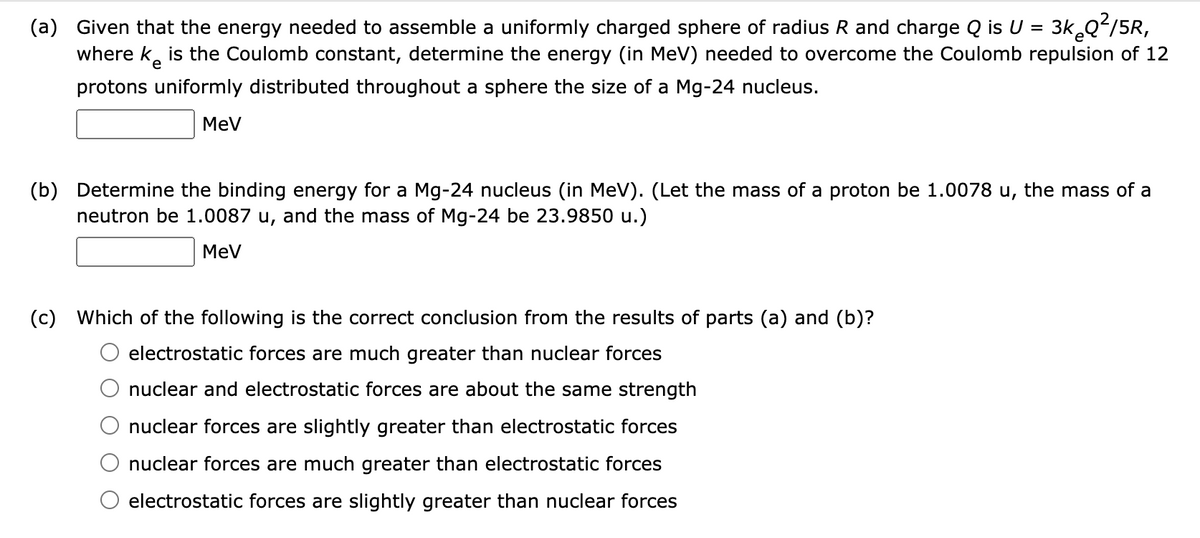(a) Given that the energy needed to assemble a uniformly charged sphere of radius R and charge Q is U = where k, is the Coulomb constant, determine the energy (in MeV) needed to overcome the Coulomb repulsion of 12 3k,Q²/5R, protons uniformly distributed throughout a sphere the size of a Mg-24 nucleus.
(a) Given that the energy needed to assemble a uniformly charged sphere of radius R and charge Q is U = where k, is the Coulomb constant, determine the energy (in MeV) needed to overcome the Coulomb repulsion of 12 3k,Q²/5R, protons uniformly distributed throughout a sphere the size of a Mg-24 nucleus.
Introductory Circuit Analysis (13th Edition)
13th Edition
ISBN:9780133923605
Author:Robert L. Boylestad
Publisher:Robert L. Boylestad
Chapter1: Introduction
Section: Chapter Questions
Problem 1P: Visit your local library (at school or home) and describe the extent to which it provides literature...
Related questions
Question

Transcribed Image Text:(a) Given that the energy needed to assemble a uniformly charged sphere of radius R and charge Q is U = 3k Qʻ/5R,
where k, is the Coulomb constant, determine the energy (in MeV) needed to overcome the Coulomb repulsion of 12
%3D
e
protons uniformly distributed throughout a sphere the size of a Mg-24 nucleus.
MeV
(b) Determine the binding energy for a Mg-24 nucleus (in MeV). (Let the mass of a proton be 1.0078 u, the mass of a
neutron be 1.0087 u, and the mass of Mg-24 be 23.9850 u.)
MeV
(c) Which of the following is the correct conclusion from the results of parts (a) and (b)?
electrostatic forces are much greater than nuclear forces
nuclear and electrostatic forces are about the same strength
nuclear forces are slightly greater than electrostatic forces
nuclear forces are much greater than electrostatic forces
electrostatic forces are slightly greater than nuclear forces
Expert Solution
This question has been solved!
Explore an expertly crafted, step-by-step solution for a thorough understanding of key concepts.
This is a popular solution!
Trending now
This is a popular solution!
Step by step
Solved in 3 steps

Knowledge Booster
Learn more about
Need a deep-dive on the concept behind this application? Look no further. Learn more about this topic, electrical-engineering and related others by exploring similar questions and additional content below.Recommended textbooks for you

Introductory Circuit Analysis (13th Edition)
Electrical Engineering
ISBN:
9780133923605
Author:
Robert L. Boylestad
Publisher:
PEARSON

Delmar's Standard Textbook Of Electricity
Electrical Engineering
ISBN:
9781337900348
Author:
Stephen L. Herman
Publisher:
Cengage Learning

Programmable Logic Controllers
Electrical Engineering
ISBN:
9780073373843
Author:
Frank D. Petruzella
Publisher:
McGraw-Hill Education

Introductory Circuit Analysis (13th Edition)
Electrical Engineering
ISBN:
9780133923605
Author:
Robert L. Boylestad
Publisher:
PEARSON

Delmar's Standard Textbook Of Electricity
Electrical Engineering
ISBN:
9781337900348
Author:
Stephen L. Herman
Publisher:
Cengage Learning

Programmable Logic Controllers
Electrical Engineering
ISBN:
9780073373843
Author:
Frank D. Petruzella
Publisher:
McGraw-Hill Education

Fundamentals of Electric Circuits
Electrical Engineering
ISBN:
9780078028229
Author:
Charles K Alexander, Matthew Sadiku
Publisher:
McGraw-Hill Education

Electric Circuits. (11th Edition)
Electrical Engineering
ISBN:
9780134746968
Author:
James W. Nilsson, Susan Riedel
Publisher:
PEARSON

Engineering Electromagnetics
Electrical Engineering
ISBN:
9780078028151
Author:
Hayt, William H. (william Hart), Jr, BUCK, John A.
Publisher:
Mcgraw-hill Education,